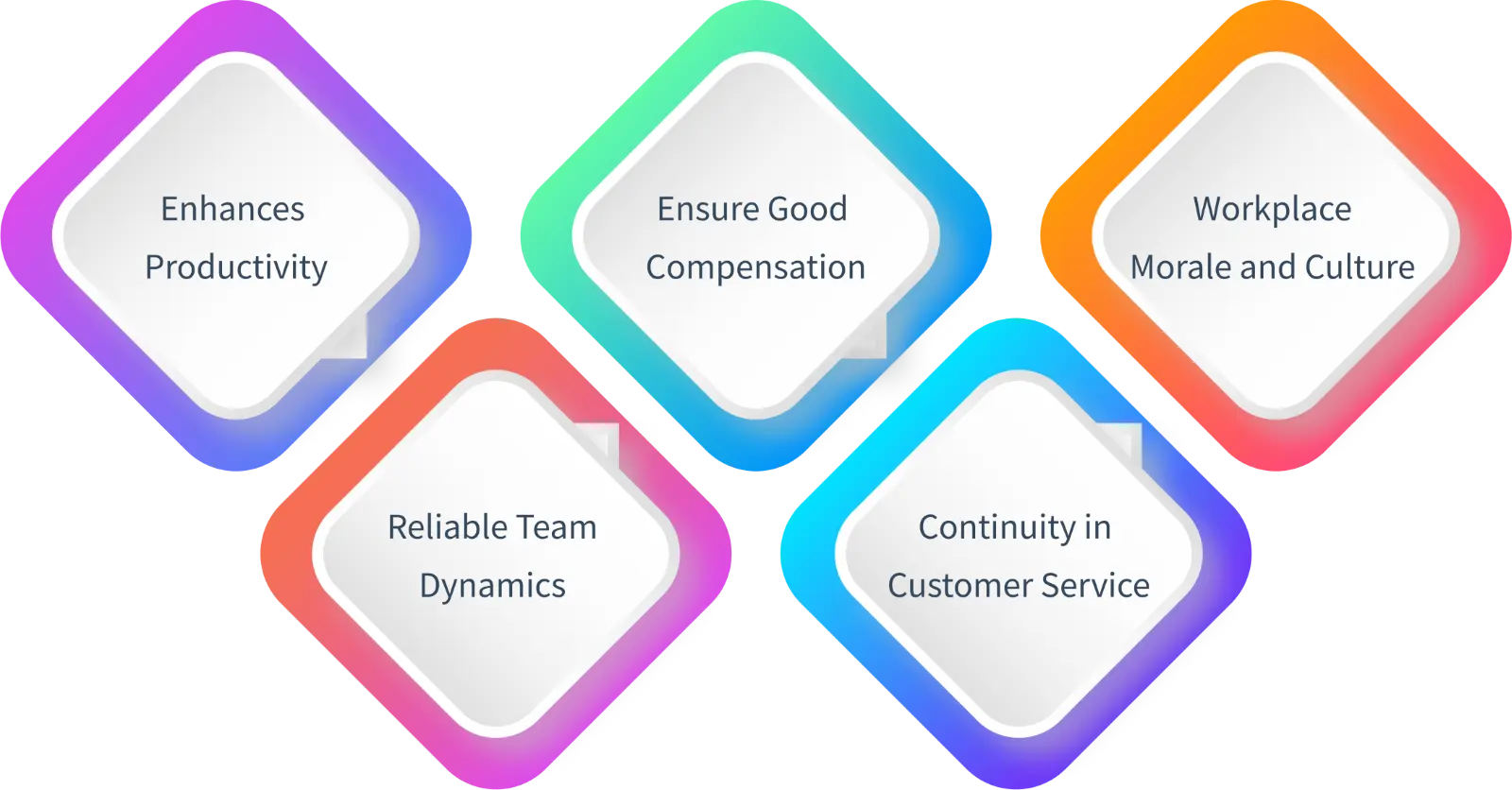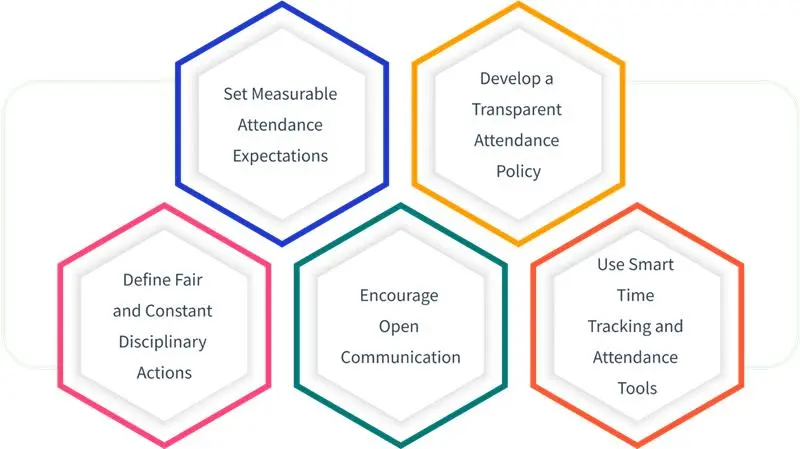A successful organisation is built on constant team attendance, that sets the groundwork for a productive and accountable work environment. Clocking in and out is a crucial part of creating a workplace that values quality, responsibility, and trust. Good attendance enables HR professionals to help their employees reach optimal performance while confidently reaching targets and giving mutual help.
In this blog, you will explore the importance of attendance , as well as effective strategies for eliminating workplace attendance challenges and tactics that connect employee presence with effective performance.
Why Is Attendance Important at Work?

Attendance is more than a process; it shows employee commitment and organizational discipline. When employees attend regularly, teams run smoothly, goals are met on time, and the workplace culture grows. The following are the fundamental reasons why attendance is vital in every productive organization.
1. Enhances Productivity
When people appear at work on time and on schedule, tasks move ahead smoothly. It ensures that projects are kept on track, deadlines are achieved, and team spirit is high. A fewer number of absences translates to fewer disruptions, hence more individual and company productivity.
2. Reliable Team Dynamics
A strong team develops on the consistency of its employees. Regular attendance promotes trust, accountability, and smooth teamwork. When one person is regularly absent, it puts extra strain on others and can upset the balance of shared tasks. Strong attendance habits lead to stronger teams.
3. Ensure Good Compensation
Accurate attendance tracking makes sure that employees get good compensation for their time and effort. It increases trust in payroll systems and encourages incentive programs based on performance. Fair pay improves employee happiness and removes pay conflicts or confusion.
4. Continuity in Customer Service
Customer experience is often determined by the employees who provide it. When employees are constantly available, client service is responsive and seamless. Consistency in attendance ensures that clients and customers receive the help they require without delay or confusion.
5. Workplace Morale and Culture
A workplace that values attendance displays a culture of respect, accountability, and support. It establishes a professional tone and pushes others to follow suit. When everyone shows up and contributes, morale and employee engagement rise.
Consequences of Poor Attendance at Workplace

When employees are frequently absent, the consequences go beyond a single person. It can slow down productivity, put stress on others, and negatively impact the overall work atmosphere. These are the consequences of poor attendance that are listed below:
1. Decreased Productivity
While the employees are absent from work, the work is delayed, d and others might have to work extra for them, and this may slow things down for everyone. The team’s attention is not focused, and tasks that would have been easy and fast to get done now take longer. Consequently, the productivity level reduces, and goals might not be achieved on time.
2. Declined Team Collaboration
Employee absences have a negative impact on teamwork. It is more difficult to communicate, share ideas, and complete projects on time. The team might start to feel disconnected, and trust can decrease. This lack of teamwork makes it harder to achieve common goals and keep the workflow running smoothly.
3. Increased Operational Costs
Frequent absences might increase the company's costs. Organizations that have frequent employee absences may need to pay overtime, recruit temporary employees, or deal with operational delays. These unexpected charges might quickly build up and hurt the budget of the company.
4. Negative Effects on Workplace Culture
The workplace starts to suffer when absences become a regular issue. Daily workers can be frustrated or overworked, and this can impact morale. Due to this negative environment, the team might get demotivated, disengaged, and distrusting.
Don’t Let Poor Attendance Hold You Back
Boost workforce reliability with effective attendance tracking. Start improving today with Time Champ!
Signup for FreeBook DemoCrucial Factors that are Affecting Attendance at Work

Even the most punctual employees sometimes face challenges that affect their attendance. Understanding the root causes of these allows HR professionals to take proactive steps to help their teams. Early detection of these issues helps companies create a work culture that promotes well-being, balance, and presence.
1. Health Concerns and Personal issues
Employees can be unable to come to work through sickness, health complications or personal emergencies. These issues are whether they are concerning physical or mental health, they may result in high levels of absenteeism if not checked. The attendance rates are high in firms that focus on health benefits, flexibility and empathy.
2. Work-Life Harmony
People must strike a balance between their professional and private lives. People who are stressed to balance between household activities and caregiving responsibilities face difficulties in good job attendance. Employees involved in flexible work schedules and hybrid work are likely to be effective in striking a balance between their personal and professional duties.
3. Commute Challenges
Long or highly contrasting commutes can deter employees from consistently working in areas where there is poor means of transport and sudden traffic jams. The stress caused by the above can be greatly reduced through remote work arrangements, alternate shifts, and transportation support.
4. Job Satisfaction and Engagement
Workers who are not satisfied with the value placed on them or disconnected from their jobs are prone to disengage and, in the process, take days off. When there is a sense of purpose and growing desire to improve within the role, it may lead to more people attending and being motivated.
Burnout can be the result of excessive workloads or poor stress management causing employees to take more time off. Companies that encourage the right expectation, mental health awareness, and open communication can minimize burnout and attendance.
Solve Attendance Challenges Easily
Try Time Champ for hassle-free attendance management!
Signup for FreeBook DemoEffective Steps to Resolve Employee Attendance Issues

Upholding attendance challenges involves more than monitoring the absences; it is also based on developing an environment which supports presence, accountability, and trust. Below are five steps through which companies can use to resolve attendance problems and develop a more reliable workforce:
Set Measurable Attendance Expectations
Clearly define what it means to maintain good attendance in your organization. When expectations are correctly communicated, from arrival times to exit routines, employees understand what is expected and can be held responsible for it fairly.
Develop a Transparent Attendance Policy
A well-written attendance policy sets the basis for consistency and clarity. Explain the different kinds of leaves, the reporting procedures, and the consequences of absences. Make it easy to find, and make sure everyone understands it during the initial onboarding and training.
Define Fair and Constant Disciplinary Actions
Create a clear, step-by-step process for handling absences and lateness. Make sure that penalties are proportionate, documented, and applied fairly to all employees. Consistency creates trust, enforces accountability, and promotes a positive work atmosphere. When disciplinary actions are fair, they are used to correct the behaviour rather than punish it.
Encourage Open Communication
Create an environment in which employees can communicate their issues of attendance without the fear of being judged. Open communication allows managers to provide timely help, make the accommodations, and keep small issues from growing.
Use Smart Time Tracking and Attendance Tools
Use modern time-tracking tools to create detailed reports, identify patterns, and automate attendance. These tools reduce manual errors, save time, and provide data in real time. Using tools like Time Champ can help organizations improve transparency, promote accountability, and simplify the management of attendance.
Pro Tip:
Looking for a sophisticated way to track employees' attendance? Time Champ might be exactly what you need. Its automated features and real-time reporting remove errors and save time.
Why not try it and benefit from a more efficient and transparent attendance management system?
Conclusion
A good environment is built upon good attendance that leads to a productive, efficient, and positive workplace experience. It enhances teamwork, boosts morale among the employees, and guarantees efficient operations. While health problems or personal issues can lead to poor attendance. Having clear expectations, fair leave policies, and using sophisticated tools like Time Champ can help reduce these issues. Organizations that prioritize attendance may create a more engaged and effective workforce, resulting in long-term success.
Strong Attendance Builds Accountable Teams
Choose Time Champ to turn attendance data into actionable insights.
Signup for FreeBook DemoFAQ’s
Yes! When the employers provide the workers with access to counselling and provide wellness initiatives and mental health, they can support the workers in mastering issues in life better, and they can reduce unscheduled absences from work.
Managers should address repeated tardiness swiftly by having one-on-one meetings, finding the core causes, and emphasizing expectations. Constant monitoring and supporting action plans are generally effective in correcting the behaviour.
Yes, flexible work hours can lead to good attendance because employees may better balance personal life and reduce stress, resulting in fewer unscheduled absences.
Incentives or bonuses based on attendance can drive certain employees, but they are most effective when combined with true recognition, professional development, and a positive work environment.





